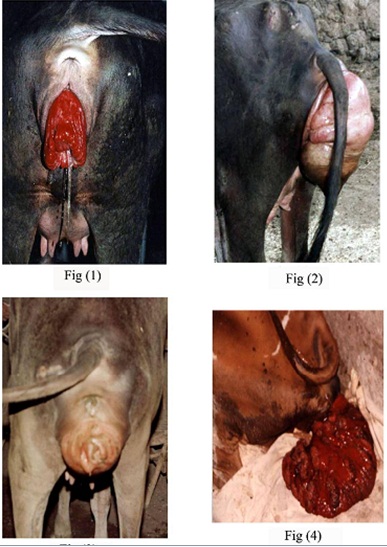This study was carried out on 81 cows (48 vaginal and 33 uterine prolapses) and 83 buffalo-cows (53 vaginal and 30 uterine prolapses) belonging to 8 commercial dairy farms located in Beni-Suef, El-Menia and El-Fayoum provinces of Egypt in the period from January 2006 to December 2008. A modified surgical technique and epidural analgesic regimen were applied on the investigated animals and compared with the field traditionally used technique. A total of 81 cases of prolapses from 3330 calveings (2.43 %) were recorded, 48 cases (1.44%) of them were vaginal prolapse and 33 cases (0.99%) were uterine prolapse. Concerning buffalo cows, out of 1680 calvings, a total of 83 cases (4.94 %) had prolapses, including 53 cases (3.15%) vaginal prolapses and 30 cases (1.78%) uterine prolapses. The incidence of reproductive tract prolapse was higher in multiparous aged cows (93.75 % and 87.88 % vaginal and uterine prolapse respectively) than in primiparous (6.25 % and 12.12 % and uterine prolapse respectively) and also higher in cows with poor body condition score (1.66 % vaginal and 1.10 % uterine) than in well fed animals with good body condition score (1.05 % vaginal and 0.91 % uterine). Buffalo cows showed the same trend. About 45.83% of cows with vaginal and 33.33% of cows with uterine prolapse previously suffered from vaginal prolapse, while only 16.66% of cows with vaginal and 12.12% of those with uterine prolapse previously suffered from uterine prolapse. This indicated that uterine prolapse is not a heritable condition, and it is not likely to reoccur, and there is no need to cull the cow as long as she breeds back, controversial to vaginal prolapses that reoccur and are heritable and needs culling of the cow and her heifer offspring. The investigated fertility parameters in unaffected animals were better than females affected with prolapses, although better non significant differences were detected with modified method than traditional ones. The incidence of postoperative complications in groups of animals treated with the modified technique were significantly (p<0.01) lower than in animals treated with traditional techniques. Concerning the survival rate of the affected animals, higher percentages were recorded after using the modified technique. Prognosis is generally favorable for uncomplicated cases when there has been no serious damage to the uterus. In conclusion, early hygienic interference and prompt treatment using the modified technique may be imperative to improve the prognosis by reducing the postoperative complications and increasing the future fertility of affected animals.


